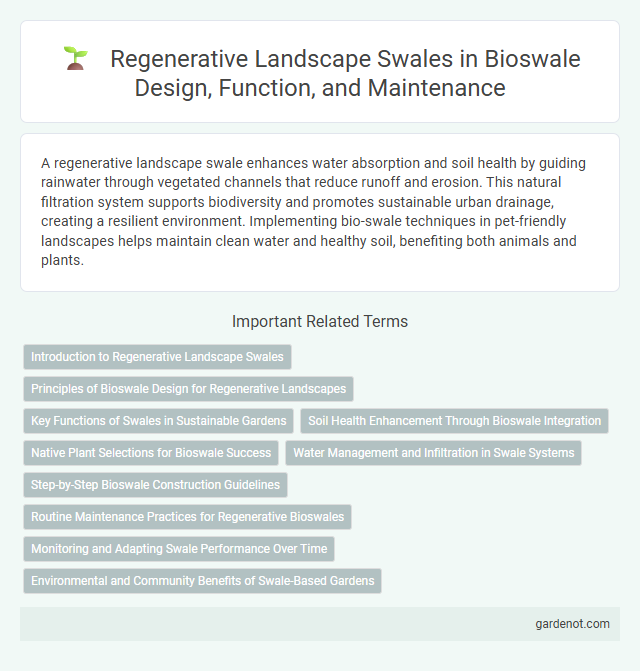A regenerative landscape swale enhances water absorption and soil health by guiding rainwater through vegetated channels that reduce runoff and erosion. This natural filtration system supports biodiversity and promotes sustainable urban drainage, creating a resilient environment. Implementing bio-swale techniques in pet-friendly landscapes helps maintain clean water and healthy soil, benefiting both animals and plants.
Introduction to Regenerative Landscape Swales
Regenerative landscape swales are engineered landforms designed to manage stormwater by capturing, infiltrating, and filtering runoff while promoting soil health and biodiversity. These swales integrate native vegetation and compost amendments to enhance water retention, reduce erosion, and facilitate groundwater recharge. By mimicking natural hydrological processes, regenerative swales support resilient ecosystems and improve overall landscape sustainability.
Principles of Bioswale Design for Regenerative Landscapes
Bioswales in regenerative landscapes harness principles such as maximizing infiltration, promoting native vegetation, and enhancing biodiversity to effectively manage stormwater and restore ecological balance. Strategic contouring and soil composition optimize water retention, while selecting deep-rooted, drought-resistant plants stabilizes soil and filters pollutants. Functionality integrates with aesthetics by supporting habitat creation, reducing erosion, and improving groundwater recharge in urban and natural environments.
Key Functions of Swales in Sustainable Gardens
Regenerative landscape swales play a critical role in sustainable gardens by effectively managing stormwater runoff, enhancing soil infiltration, and preventing erosion. They support groundwater recharge through the slow absorption of water, promoting healthy plant growth and biodiversity within garden ecosystems. Swales also act as natural filtration systems, trapping sediments and pollutants to improve water quality and reduce environmental impact.
Soil Health Enhancement Through Bioswale Integration
Regenerative landscape swales enhance soil health by promoting natural water infiltration and reducing surface runoff, which increases soil moisture retention and nutrient availability. These bioswales facilitate the accumulation of organic matter and support microbial activity, improving soil structure and fertility. Integrating bioswales into landscape designs contributes to sustainable water management and fosters resilient ecosystems with enriched soil biodiversity.
Native Plant Selections for Bioswale Success
Native plant selections play a crucial role in the success of regenerative landscape swales by enhancing soil stability, improving water filtration, and supporting local biodiversity. Deep-rooted native grasses and wildflowers increase infiltration rates and reduce erosion, while their adaptation to regional climate conditions minimizes maintenance needs. Incorporating diverse native species ensures resilient ecosystem functions, promoting long-term sustainability and improved stormwater management in bioswales.
Water Management and Infiltration in Swale Systems
Regenerative landscape swales enhance water management by capturing, slowing, and infiltrating stormwater runoff directly into the soil, reducing surface erosion and improving groundwater recharge. These swale systems often incorporate native vegetation and engineered soil layers to maximize infiltration rates and nutrient absorption, promoting healthier ecosystems. Optimized swale design can mitigate urban flooding and support sustainable water cycles through natural filtration and enhanced subsurface water flow.
Step-by-Step Bioswale Construction Guidelines
Constructing a regenerative landscape bioswale begins with site assessment to identify optimal water flow and soil conditions. Excavate a shallow, elongated depression with a gentle slope, ensuring dimensions accommodate expected runoff volume. Incorporate native, water-tolerant plants and amend soil with organic matter to enhance filtration, promote groundwater recharge, and support ecosystem health.
Routine Maintenance Practices for Regenerative Bioswales
Routine maintenance practices for regenerative bioswales include regular inspection to ensure proper water infiltration and vegetation health. Removing accumulated sediment and debris prevents clogging, maintaining optimal flow and pollutant removal efficiency. Periodic replanting and pruning of native plants support biodiversity and reinforce soil stabilization for sustained ecosystem function.
Monitoring and Adapting Swale Performance Over Time
Regenerative landscape swales require consistent monitoring of water infiltration rates, soil moisture levels, and vegetation health to ensure optimal performance. Employing sensors and regular visual inspections allows for timely identification of blockages, erosion, or sediment buildup that could impair functionality. Adaptive management strategies, such as adjusting planting schemes or enhancing soil amendments, are crucial to maintaining long-term swale efficacy and promoting sustainable stormwater management.
Environmental and Community Benefits of Swale-Based Gardens
Regenerative landscape swales enhance soil moisture retention, reduce stormwater runoff, and improve groundwater recharge, creating healthier urban ecosystems. These swale-based gardens support biodiversity by providing habitats for native plants and pollinators while filtering pollutants from runoff. Community engagement with swale gardens fosters environmental education, green space accessibility, and local stewardship, promoting sustainable urban living.
Regenerative landscape swale Infographic

 gardenot.com
gardenot.com